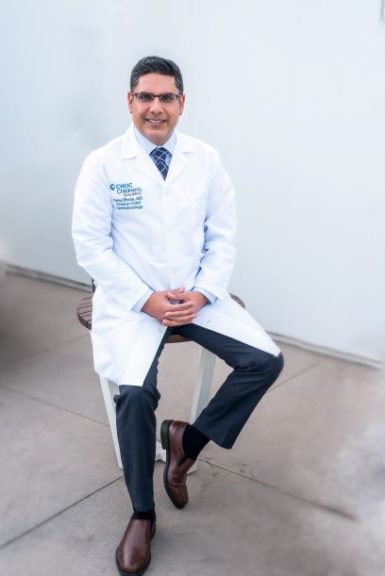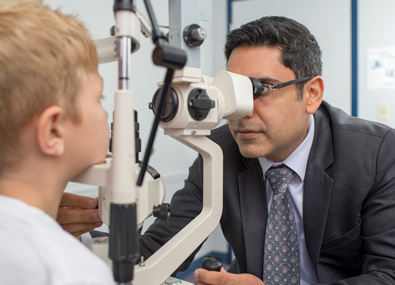During his nearly 20 years as a pediatric ophthalmologist, Dr. Rahul Bhola has performed thousands of surgeries to correct strabismus, a condition in which the eyes are misaligned and do not track together.
And after each procedure, he feels an immense sense of gratitude for being able to profoundly affect the lives of children who, by the critical age of around 5, stand the best chance for successful outcomes before their brains get used to living comfortably with eye misalignment.
“What drives me is the patients we treat,” says Dr. Bhola, division chief of CHOC’s Specialists Ophthalmology and an associate clinical professor at UC Irvine School of Medicine. “The biggest thing is early diagnosis and prompt management, and with these surgical procedures, I can see the results right away. What can be better than that?”

Already the recipient of numerous national and international awards, Dr. Bhola, who joined CHOC in July 2017, continues to break new ground.
Recently, a paper he presented at a global conference of the World Society of Paediatric Ophthalmology and Strabismus won top honors in the category of innovation and strabismus surgery.
During his presentation at the WSPOS’ World Wide Connect 2020, Dr. Bhola described a new approach to surgically correct strabismus in kids diagnosed with horizontal misalignment associated with minimal vertical misalignment.
Traditionally, most surgeons would surgically correct the horizontal misalignment and hope the vertical condition would work itself out. There’s a risk, Dr. Bhola explains, in surgically correcting for mild vertical misalignment. The procedure involves cutting off and repositioning a muscle in a different spot, which can result in an overcorrection – thus making things worse than better.
Dr. Bhola came up with the idea of performing what he calls graded marginal myotomy of inferior oblique. Instead of cutting and repositioning the muscle off the eyeball, he makes an incision to weaken the muscle avoiding the potential risks of overcorrection and by grading is able to adjust the amount of vertical strabismus correction.
“We use prisms to measure the degree of misalignment to better determine how much we need to weaken the muscle,” he explains.
Dr. Bhola says he’s performed the technique on some 60 patients with excellent results.
“It sounds very intuitive, it sounds very easy, but it had never been done before,” he says.
Dr. Bhola says the paper he presented at the conference is expected to be published soon in a major medical journal.
“This (surgery) will be a great addition to our armamentarium of strabismus surgery,” he says.

Fixing the problem in one procedure
Strabismus is prevalent in about 5-7 percent of the pediatric population, Dr. Bhola says. In most cases, the condition is the result of an abnormality of the neuromuscular control of eye movement. Many children who undergo surgery for strabismus need about two to three surgeries in their lifetime for the condition to be adequately corrected, he adds.
Not so with his recently developed procedure.
“That’s one of the beauties of this surgery,” says Dr. Bhola, explaining that he’s able to correct both horizontal and vertical misalignment in one procedure.
“The chances of achieving a good outcome is best with the first surgery,” Dr. Bhola says.” In my experience, it’s best to be aggressive and adequately correct both horizontal and vertical misalignment in order to get the best possible surgical outcome.”
When Dr. Bhola joined CHOC a little more than three years ago, he was tasked with developing CHOC’s Ophthalmology Division into a destination center in Orange County and beyond.
He’s well on his way.
In 2019, CHOC’s Ophthalmology Division saw 5,500 patients (equating to 8,000 patient visits) with a 90-percent-plus patient satisfaction rate, Dr. Bhola says.
“We’re seeing exponential growth,” adds Dr. Bhola, who plans to grow the division to five or so specialists over the next few years. Currently, the division has two.
After graduating from medical school in 1996 and completing his first Ophthalmology residency from University of Delhi, India, Dr. Bhola further pursued another residency in Ophthalmology in the US. He went on to do his Pediatric Ophthalmology fellowship from two prestigious ophthalmology training programs. He says he always wanted to be a pediatrician and later fell in love with ophthalmology, and being able to practice Ophthalmology at CHOC, a world class pediatric hospital, gave him the best of both worlds.
“This is something I’m passionate about,” he says.
To learn more about Ophthalmology at CHOC, click here.




